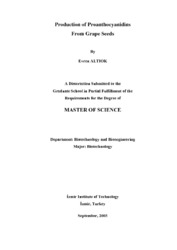Please use this identifier to cite or link to this item:
https://hdl.handle.net/11147/3732Full metadata record
| DC Field | Value | Language |
|---|---|---|
| dc.contributor.advisor | Ülkü, Semra | - |
| dc.contributor.author | Altıok, Evren | - |
| dc.date.accessioned | 2014-07-22T13:52:14Z | - |
| dc.date.available | 2014-07-22T13:52:14Z | - |
| dc.date.issued | 2003 | - |
| dc.identifier.uri | http://hdl.handle.net/11147/3732 | - |
| dc.description | Thesis (Master)--Izmir Institute of Technology, Biotechnology, Izmir, 2003 | en_US |
| dc.description | Includes bibliographical references (leaves: 56-61) | en_US |
| dc.description | Text in English;Abstract: Turkish and English | en_US |
| dc.description | x, 79 leaves | en_US |
| dc.description.abstract | Proanthocyanidin is a potent antioxidant that is why it directly affects many important diseases such as coronary heart disease, cholesterol etc. Thus, proanthocyanidin is one of the important dietary supplements, which is mainly found in grape seeds. In this study the extraction of this valuable antioxidant from grape seeds was studied. For the extraction of proanthocyanidins, different solvents such as ethanol, methanol, acetone and their aqueous forms were used. The maximum extraction yield was achieved after 24 h at room temperature. It was observed that 70% aqueous acetone was the best solvent with the highest yield of 17.5%. Yield of proanthocyanidin extracted with 70% aqueous acetone was 3 times greater than proanthocyanidins extracted with other solvents. The extract was freeze dried to obtain the product as powdered form. To compare the product with commercial ones HPLC chromatograms and FTIR spectra were taken and similar spectra were obtained. With HPLC, monomers of proanthocyanidins; (+)-catechin and (-)- epicatechin were determined. (+)-catechin was observed at 17.2 min as 3.06%w/w. Also, (-)-epicatechin was observed at 42.8 min as 1.99%w/w. Most of the drying methods are performed at high temperatures which may result negative effects on proanthocyanidin`s antioxidant capacity. Even the applications at low temperatures in case of freeze-drying have some disadvantages e.g. the process takes a long time, it is expensive and has some difficulties. Therefore as an alternative to other concentration and drying techniques, adsorption process was thought to be a promising technique. Although adsorption of proanthocyanidins on zeolites were not obtained, removal of excess water from the extracts can be achieved by using zeolites. This would possess as a promising technique for the concentration of the end productThe antioxidant capacities of proanthocyanidins from the grape seed extracts were also determined. Proanthocyanidin has an antioxidant capacity with 57 TEAC value, which is more than synthetic antioxidants; BHT, BHA, TBHQ and PG, 6.66, 0.593, 1.168 and 12.62 TEAC respectively. . | en_US |
| dc.language.iso | en | en_US |
| dc.publisher | Izmir Institute of Technology | en_US |
| dc.rights | info:eu-repo/semantics/openAccess | en_US |
| dc.subject.lcc | TP159.A5 A45 2003 | en |
| dc.subject.lcsh | Antioxidants | en |
| dc.subject.lcsh | Grapes--Seeds | en |
| dc.subject.lcsh | Flovanoids | en |
| dc.subject.lcsh | Fouries transform infrared spectroscopy | en |
| dc.subject.lcsh | High performance liquid chromatography | en |
| dc.title | Production of Proanthocyanidins From Grape Seed | en_US |
| dc.type | Master Thesis | en_US |
| dc.institutionauthor | Altıok, Evren | - |
| dc.department | Thesis (Master)--İzmir Institute of Technology, Bioengineering | en_US |
| dc.relation.publicationcategory | Tez | en_US |
| dc.identifier.wosquality | N/A | - |
| dc.identifier.scopusquality | N/A | - |
| item.languageiso639-1 | en | - |
| item.grantfulltext | open | - |
| item.fulltext | With Fulltext | - |
| item.openairecristype | http://purl.org/coar/resource_type/c_18cf | - |
| item.openairetype | Master Thesis | - |
| item.cerifentitytype | Publications | - |
| Appears in Collections: | Master Degree / Yüksek Lisans Tezleri | |
Files in This Item:
| File | Description | Size | Format | |
|---|---|---|---|---|
| T000247.pdf | MasterThesis | 424.92 kB | Adobe PDF |  View/Open |
CORE Recommender
Page view(s)
478
checked on Jun 16, 2025
Download(s)
354
checked on Jun 16, 2025
Google ScholarTM
Check
Items in GCRIS Repository are protected by copyright, with all rights reserved, unless otherwise indicated.